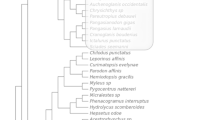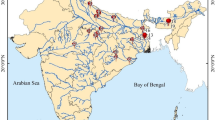Abstract
Two MHC class II loci, DAB (a classical class II locus) and DXB (putatively a non-classical class II locus), were sequenced in samples of individuals from two populations of swordtail fish, **phophorus multilineatus and X. pygmaeus. The DAB locus showed higher levels of genetic variation in the B1-encoding region, (putative binding region) than the DXB locus. We used two methods to investigate dN/dS ratios. The results from a maximum likelihood method based on phylogenetic relationships indicated positive selection on the B1 region of DAB (this method could not be used on DXB). Results from a coalescent-based method also showed evidence for positive selection in the B1 region of DAB, but only weak evidence for selection on the DXB. Further analyses indicated that recombination is an important source of variation in the B1 region of DAB, but has a relatively small effect on DXB. Overall, our results were consistent with the hypothesis that the DAB locus is under positive selection driven by antagonistic coevolution, and that the DXB locus plays the role of a non-classical MHC II locus. We also used simulations to investigate the presence of an elevated synonymous substitution rate in the binding region. The simulations revealed that the elevated rate could be caused by an interaction between positive selection and codon bias.



Similar content being viewed by others
References
Alfonso C, Karlsson L (2000) Nonclassical MHC class II molecules. Annu Rev Immunol 18:113–142
Altschul SF, Gish W, Miller W et al (1990) Basic local alignment search tool. J Mol Biol 215:403–410
Anders A, Petry H, Fleming C et al (1994) Increasing melanoma incidence: putatively explainable by retrotransposons. Experimental contributions of the xiphophorine Gordon-Kosswig melanoma system. Pigment Cell Res 7:433–450
Anisomova M, Nielsen R, Yang Z (2003) Effect of recombination on the accuracy of the likelihood method for detecting positive selection at amino acid sites. Genetics 168:1229–1236
Borriello F, Krauter KS (1990) Reactive site polymorphism in the murine protease inhibitor gene family is delineated using a modification of the PCR reaction (PCR +1). Nucleic Acids Res 18:5481–5487
Comeron JM, Kreitman M (1998) The correlation between synonymous and nonsynonymous substitutions in Drosophila: mutation, selection or relaxed constraints? Genetics 150:767–775
Cresswell P (1996) Invariant chain structure and MHC class II function. Cell 84:505–507
Doxiadis GGM, van der Wiel MKH, Brok HPM et al (2006) Reactivation by exon shuffling of a conserved HLA-DR3-like pseudogene segment in a new world primate species. PNAS 103:5864–5868
Dumont VB, Fay JC, Calabrese PP et al (2004) DNA variability and divergence at the notch locus in Drosophila melanogaster and D. simulans: a case of accelerated synonymous site divergence. Genetics 167:171–185
Edwards SV, Gasper J, March M (1998) Genomics and polymorphism of Agph-DAB1, an Mhc class II B gene in red-winged blackbirds (Agelaius phoneniceus). Mol Biol Evol 15:236–250
Figueroa F, Mayer WE, Sultmann H et al (2000) Mhc class II B gene evolution in East African cichlid fishes. Immunogenetics 51:556–575
Garrigan D, Hedrick PW (2003) Detecting adaptive molecular polymorphism: lessons from the MHC. Evolution 57:1707–1722
Graser R, O’HUigin C, Vincek V et al (1996) Trans-species polymorphism of class II Mhc loci in danio fishes. Immunogenetics 44:36–48
Green PJ (1995) Reversible jump Markov chain Monte Carlo computation and Bayesian model determination. Biometrika 82:711–732
Hamilton WD, Axelrod R, Tanese R (1990) Sexual reproduction as an adaption to resist parasites. Proc Natl Acad Sci USA 87:3566–3573
Hardee JJ, Godwin U, Benedetto R et al (1995) Major histocompatibility complex class II A gene polymorphism in the striped bass. Immunogenetics 41:229–238
Hedrick PW, Lee RN, Garrigan D (2002) Major histocompatibility complex variation in red wolves: evidence for common ancestry with coyotes and balancing selection. Mol Ecol 11:1905–1913
Hudson RR (2001) Two-locus sampling distributions and their application. Genetics 159:1805–1817
Hudson RR, Kaplan N (1985) Statistical properties of the number of recombination events in the history of a sample of DNA sequences. Genetics 111:147–164
Hughes AL (1999) Adaptive evolution of genes and genomes. Oxford University Press, New York
Hughes AL (2002) Natural selection and the diversification of vertebrate immune effectors. Immunol Rev 190:161–168
Hughes AL, Nei M (1989) Nucleotide substitution at major histocompatibility complex class II loci: evidence for overdominant selection. Proc Natl Acad Sci USA 86:958–962
Hughes AL, Yeager M (1998a) Natural selection at major histocompatibility complex loci of vertebrates. Annu Rev Genet 32:415–435
Hughes AL, Yeager M (1998b) Natural selection and the evolutionary history of major histocompatibility complex loci. Front Biosci 3:d509–d516
Kallman KD (1958) Genetics of fin transplantation in xiphophorin fishes. Ann NY Acad Sci 73:599–610
Kallman KD (1964) An estimate of the number of histocompatability loci in the teleost **phophorus maculatus. Genetics 50:583–595
Kazianis S, Gimenez-Conti I, Setlow RB et al (2001) MNU induction of neoplasia in a platyfish model. Lab Invest 81:1191–1198
Kropshofer H, Vogt AB, Thery C et al (1998) A role for HLA-DO as a co-chaperone of HLA-DM in peptide loading of MHC class II molecules. EMBO J 17:2971–2981
Kumar S, Tamura K, Jakobsen IB et al (2001) MEGA2: molecular evolutionary genetics analysis software. Bioinformatics 17:1244–1245
Li N, Stephens M (2003) Modelling linkage disequilibrium and identifying recombination hotspots using single-nucleotide polymorphism data. Genetics 165:2213–2233
Lipman DJ, Wilbur WJ (1984) Interaction of silent and replacement changes in eukaryotic coding sequences. J Mol Evol 21:161–167
Maddison WP, Maddison DR (2007) Mesquite: a modular system for evolutionary analysis. Version 2.01. http://mesquiteproject.org
McConnell TJ, Godwin UB, Norton SF et al (1998a) Identification and map** of two divergent, unlinked major histocompatibility complex class II B genes in **phophorus fishes. Genetics 149:1921–1934
McConnell TJ, Godwin UB, Cuthbertson BJ (1998b) Expressed major histocompatibility complex class II loci in fishes. Immunol Rev 166:294–300
McVean G, Awadalla P, Fearnhead PA (2002) Coalescent-based method for detecting and estimating recombination rates from gene sequences. Genetics 160:1231–1241
McVean G, Myers SR, Hunt S et al (2004) The fine-scale structure of recombination rate variation in the human genome. Science 304:581–584
Miller KM, Withler RE (1996) Sequence analysis of a polymorphic Mhc class II gene in Pacific salmon. Immunogenetics 43:337–351
Naruse TK, Kawata H, Inoko H et al (2002) The HLA-DOB gene displays limited polymorphism with only one amino acid substitution. Tissue Antigens 59:512–519
Neefjes J (1999) CIIV, MIIC and other compartments for MHC class II loading. Eur J Immunol 29:1421–1425
Nei M, Kumar S (2000) Molecular evolution and phylogenetics. Oxford University Press
Nielsen R, Yang Z (1998) Likelihood models for detecting positively selected amino acid sites and applications to the HIV-1 envelope gene. Genetics 148:929–936
Reusch TBH, Langefors A (2005) Inter- and intralocus recombination drive MHC class IIB gene diversification in a teleost, the three-spined stickleback Gasterosteus aculeatus. J Mol Evol 61:531–541
Richman AD, Herrera LG, Nash D et al (2003) Relative roles of mutation and recombination in generating allelic polymorphism at an MHC class II locus in Peromyscus maniculatus. Genet Res Camb 82:89–99
Richman AD, Herrera G, Reynoso VH et al (2007) Evidence for balancing selection at the DAB locus in the axolotl, Ambystoma mexicanum. Int J Immunogenet 34:475–478
Robbins NF, Hammond C, Denzin LK et al (1996) Trafficking of major histocompatibility complex class II molecules through intracellular compartments containing HLA-DM. Hum Immunol 45:13–23
Roney KE, Cuthbertson BJ, Godwin UB et al (2004) Alternative splicing of major histocompability complex class II DXB transcripts in **phophorus fishes. Immunogenetics 56:462–466
Rozas J, Sanchez-Delbarrio J, Messeguer X et al (2003) DnaSP, DNA polymorphism analyses by the coalescent and other methods. Bioinformatics 19:2496–2497
Servenius B, Rask L, Peterson PA (1987) Class II genes of the human major histocompatibility complex. The DO beta gene is a divergent member of the class II beta gene family. J Biol Chem 262:8759–8766
Swofford DL (2003) PAUP*. Phylogenetic analysis using parsimony (*and other methods). Version 4. Sinauer Associates, Sunderland, Massachusetts
Thompson JD, Eibson TJ, Plewniak F, Jeaurnougin F, Higgins DE (1997) The Clustal X windows interface: flexible strategies for multiple sequence alignment aided by quality analysis tools. Nuc Acid Res 24:4876–4882
Walter W, Loos M, Maeurer MJ (1996) H2-M polymorphism in mice susceptible to collagen-induced arthritis involves the peptide binding groove. Immunogenetics 44:19–26
Wang JH, Reinherz EL (2002) Structural basis of T cell recognition of peptides bound to MHC molecules. Mol Immunol 38:1039–1049
Wilson DJ (2006) OmegaMap version 0.5. http://www.danielwilson.me.UK/software.html
Wilson DJ, McVean G (2006) Estimating diversifying selection and functional constraint in the presence of recombination. Genetics 172:1411–1425
Yang Z (1997) PAML: a program package for phylogenetic analysis by maximum likelihood CABIOS 13:555–556. http://abacus.gene.ucl.ac.uk/software/paml.html
Yang Z (2001) Adaptive molecular evolution. In: Balding DJ (ed) Handbook of statistical genetics, John Wiley Sons, New York, pp 327–350
Yang Z, Bielawski JP (2000) Statistical methods to detect molecular adaptation. Trends Ecol Evol 15:495–503
Zhang J, Nielsen R, Yang Z (2005) Evaluation of an improved branch-site likelihood method for detecting positive selection at the molecular level. Mol Biol Evol 22:2472–2479
Acknowledgements
This research was supported by NSF grant #MCB 0110541 to Thomas McConnell. We thank Felix Breden and four anonymous reviewers for comments on the manuscript. This paper is dedicated to the memory of Steven Kazianis.
Author information
Authors and Affiliations
Corresponding author
Electronic supplementary material
Below is the link to the electronic supplementary material.
Rights and permissions
About this article
Cite this article
Summers, K., Roney, K.E., da Silva, J. et al. Divergent patterns of selection on the DAB and DXB MHC class II loci in **phophorus fishes. Genetica 135, 379–390 (2009). https://doi.org/10.1007/s10709-008-9284-4
Received:
Accepted:
Published:
Issue Date:
DOI: https://doi.org/10.1007/s10709-008-9284-4




